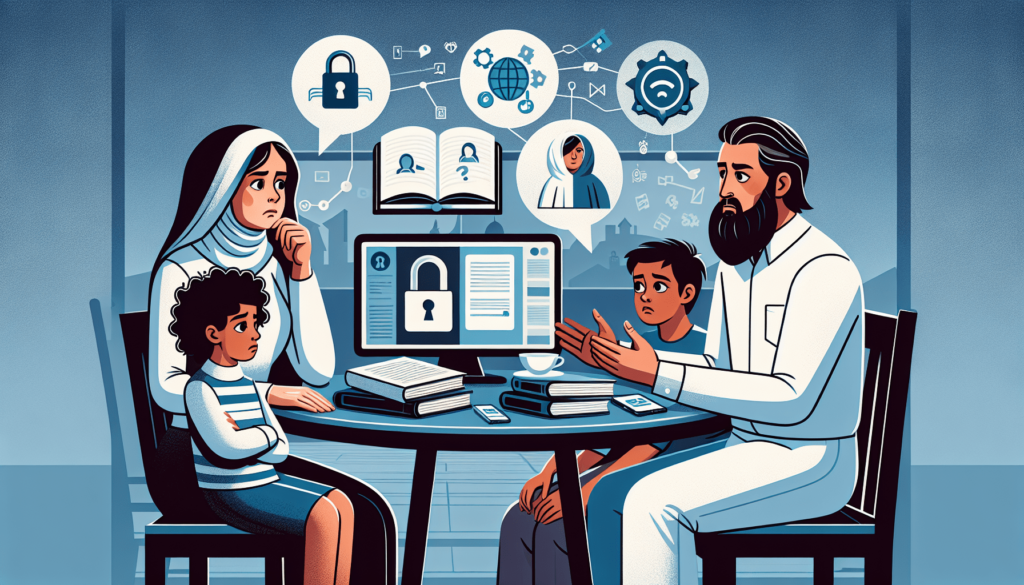In today’s digital age, it is essential for parents to discuss the topics of social engineering and online safety with their children. The rapid development of technology has brought numerous opportunities, but it has also exposed our kids to potential dangers and vulnerabilities. This article will guide you through effective strategies and essential conversations that can empower you to have meaningful discussions with your kids about the risks associated with social engineering and how to stay safe online. By equipping yourself with the right knowledge and tools, you can help protect your children and foster a secure online environment for their growth and development.

Explaining Social Engineering
Defining social engineering
Social engineering refers to the manipulation of individuals, often through psychological tactics, to gain unauthorized access to confidential information or to influence their behavior. It involves exploiting human psychology rather than technological vulnerabilities. Social engineers employ various techniques such as deception, manipulation, and impersonation to trick their targets into revealing sensitive information or performing actions that can be exploited.
Examples of social engineering tactics
Social engineers use a wide range of tactics to deceive individuals and gain their trust. Some common techniques include phishing, pretexting, baiting, and tailgating. Phishing involves sending emails or messages that appear to come from a legitimate source, tricking users into divulging their login credentials or financial information. Pretexting involves creating a false identity or story to manipulate targets into revealing confidential information. Baiting includes leaving a bait, such as a USB drive infected with malware, in a public place to entice unsuspecting users to plug it into their computers. Tailgating involves following someone into a restricted area by exploiting their trust.
Emphasizing the importance of awareness
Awareness is crucial in defending against social engineering attacks. By educating yourself about the tactics used by social engineers, you can better recognize and avoid falling victim to their schemes. It is important to be skeptical, question requests for personal information, and verify the legitimacy of any communication or requests you receive. Additionally, being aware of the potential dangers of social engineering can help you spot red flags and maintain a higher level of overall online safety.
Teaching Online Safety Basics
Internet etiquette and responsible behavior
Teaching internet etiquette and responsible behavior is essential to ensure a safe and respectful online environment. Emphasize the importance of being kind and respectful to others when communicating online. Teach children to think before they post or share anything online, as their actions can have consequences. Encourage them to report any inappropriate behavior they encounter and to seek permission before sharing others’ personal information.
Importance of strong passwords
Strong passwords are the first line of defense against unauthorized access to online accounts. Educate your children about creating unique and complex passwords that are difficult to guess. Teach them not to share their passwords with anyone and to change them regularly. Password managers can be a helpful tool for maintaining strong, unique passwords across multiple accounts.
Recognizing and avoiding phishing scams
Phishing scams are a common social engineering tactic that can lead to identity theft or financial loss. Teach your children to be cautious of unsolicited emails, messages, or phone calls asking for personal information or sharing alarming news. Encourage them to verify the authenticity of the communication and to never click on suspicious links or download attachments from unknown sources.
Safe browsing habits
Educate your children about safe browsing habits to minimize the risk of malware infections or exposure to inappropriate content. Teach them to stick to reputable websites, avoid clicking on pop-up ads, and be cautious when downloading files or installing software. Explain the importance of keeping their devices and software up to date with the latest security patches to protect against known vulnerabilities.
Ensuring Privacy and Security
Understanding the importance of privacy
Help your children understand the importance of privacy and the potential consequences of oversharing personal information online. Discuss with them the concept of permanent digital footprints and how personal information can be used by malicious actors or for unwanted online targeting. Encourage them to be mindful of what they share, especially on public platforms.
The dangers of oversharing
Explain to your children the risks associated with oversharing personal information online. Oversharing can lead to identity theft, cyberbullying, stalking, or even physical harm. Encourage them to think critically before sharing personal information such as their full name, address, phone number, school name, or vacation plans. Teach them to consider the potential audience and long-term consequences of their online actions.
Securing personal information online
Provide guidance on how to secure personal information online. Teach your children to use privacy settings on social media platforms to control who can view their posts and profile information. Encourage them to use pseudonyms or selective sharing to limit exposure. Teach them to be cautious about the information they provide on online forms and to think twice before sharing personal details in public domains.
Explaining the risks of public Wi-Fi
Discuss the risks associated with using public Wi-Fi networks. Explain that public Wi-Fi networks are often unsecured, making it easier for attackers to intercept sensitive information. Encourage your children to use virtual private networks (VPNs) when connecting to public Wi-Fi to encrypt their data and protect their online activities. Emphasize the importance of avoiding online banking or sharing sensitive information while connected to public Wi-Fi.
Identifying and Avoiding Online Threats
Types of online threats (malware, ransomware, etc.)
Educate your children about different types of online threats they may encounter. Explain the risks of malware, which can infect devices and steal personal information, and ransomware, which can lock users out of their systems until a ransom is paid. Teach them to be cautious of suspicious links or attachments and to regularly scan their devices for malware.
Protecting against viruses and malicious websites
Teach your children about the importance of antivirus software, firewall protection, and secure web browsers in defending against viruses and malicious websites. Show them how to install and update antivirus software, enable firewalls, and use web browsers with built-in security features. Encourage them to be cautious of websites that display warning signs, such as unsecured connections or suspicious content.
Ad-blocking software and safe downloads
Explain the benefits of using ad-blocking software to your children. Ad-blocking software helps prevent malicious ads from infecting their devices with malware. Additionally, teach them to download content only from reputable sources and to avoid suspicious websites or peer-to-peer file sharing platforms. Emphasize the importance of scanning downloaded files for malware before opening them.
Safe practices for online gaming and file sharing
Online gaming and file sharing platforms can be potential sources of online threats. Teach your children safe practices when engaging in these activities. Encourage them to only download games or files from trusted sources and to be cautious of suspicious links or file attachments shared with them. Remind them to only interact with known and trusted individuals online and to report any suspicious or inappropriate behavior.

Educating on Social Media Safety
Understanding the risks of social media
Help your children understand the potential risks associated with social media platforms. Discuss the importance of carefully managing their online presence and the potential consequences of sharing personal information or engaging in inappropriate behavior on social media. Emphasize the need to think critically before accepting friend requests or engaging with strangers online.
Privacy settings and account security
Teach your children how to configure privacy settings on social media platforms to limit the visibility of their personal information and activities. Encourage them to review and adjust these settings regularly. Instruct them on the importance of keeping their account credentials secure by using strong passwords and enabling multi-factor authentication whenever possible.
Avoiding cyberbullying and online harassment
Discuss the topics of cyberbullying and online harassment with your children. Teach them the importance of treating others with respect online and how to recognize and report instances of cyberbullying or harassment. Encourage them to be empathetic and inclusive, and to be supportive of others who may be experiencing such behavior.
Recognizing and reporting suspicious behavior
Teach your children to recognize and report suspicious behavior on social media platforms. Make them aware of signs of grooming, bullying, or predatory behavior. Instruct them on how to report harmful content or suspicious accounts to the appropriate authorities or platform moderators.
Detecting Fake News and Misinformation
What is fake news and why it’s harmful
Explain the concept of fake news and why it is harmful. Help your children understand that fake news spreads misinformation, influences public opinion, and can have significant consequences on individuals and society. Teach them to be critical thinkers and to evaluate the credibility of sources before believing or sharing information.
Teaching critical thinking skills
Develop your children’s critical thinking skills to help them differentiate between reliable and unreliable sources of information. Teach them to question the source, author, evidence, and potential bias of information they encounter online. Encourage them to seek multiple perspectives and to evaluate contrasting viewpoints before forming their own judgments.
Verifying sources and fact-checking
Guide your children on how to verify the credibility of sources and fact-check information before accepting it as true. Teach them to look for corroborating evidence from multiple reputable sources and to consult fact-checking websites or organizations. Encourage them to share accurate information with others and to correct misinformation when they encounter it.
Promoting media literacy
Emphasize the importance of media literacy skills in navigating the digital landscape. Help your children understand the techniques used in persuasive media, such as emotional appeals and sensationalism. Teach them to critically analyze media content, including videos, images, and articles, to identify potential biases, misinformation, or propaganda.
Encouraging open communication
Creating a safe environment for discussions
Create a safe and non-judgmental environment for your children to discuss their online experiences and concerns. Encourage open communication and make it clear that they can come to you with any questions or issues they encounter. Establishing a trusting relationship will help them feel comfortable seeking guidance and support when needed.
Listening actively and without judgment
When your children approach you with questions or concerns, listen actively and without judgment. Offer them your full attention and make them feel heard and understood. Avoid reacting with anger or blame, as this may discourage them from seeking your guidance in the future.
Answering questions honestly
When discussing online safety, answer your children’s questions honestly and age-appropriately. Be transparent about the risks and potential consequences while also providing practical guidance and actionable steps to mitigate them. Provide real-life examples and encourage discussion to deepen their understanding.
Building trust and encouraging report of threats
Building trust is essential to ensure your children feel comfortable reporting online threats or suspicious behavior. Assure them that their safety is your utmost priority and that you will take their concerns seriously. Encourage them to report any instances of cyberbullying, harassment, or other threats they encounter, and assure them that you will support and guide them through the process.
Setting Rules and Establishing Boundaries
Creating family rules for internet usage
Establish clear rules and expectations regarding internet usage within your family. Set time limits for screen time, define what content is allowed, and discuss consequences for breaking the rules. Involve your children in the rule-setting process to foster their sense of ownership and responsibility.
Setting screen time limits
Help your children develop healthy technology habits by setting reasonable screen time limits. Strive for a balance between online activities and other aspects of their lives, such as academic work, physical exercise, and social interactions. Encourage them to prioritize offline activities and maintain a healthy balance.
Establishing online boundaries
Teach your children the importance of setting boundaries in their online interactions. Discuss what is appropriate and acceptable behavior online and guide them on how to protect their personal information and privacy. Encourage them to be assertive in asserting their boundaries and to seek help when they feel uncomfortable or threatened.
Teaching self-regulation and healthy technology habits
Foster self-regulation skills in your children to promote healthy technology habits. Teach them to manage their time effectively, take regular breaks from screens, and develop offline hobbies and interests. Encourage them to make conscious choices about their online activities and to prioritize their overall well-being.
Teaching Critical Online Behavior
Teaching skepticism and questioning information
Promote skepticism and critical thinking in your children’s online behavior. Teach them to question information they encounter, especially if it seems too good to be true or aligns with their pre-existing beliefs without credible evidence. Encourage them to seek diverse and reliable sources before accepting information as true.
Awareness of online scams and frauds
Educate your children about common online scams and frauds, such as advance-fee frauds or pyramid schemes. Teach them to be cautious of unsolicited requests for money or personal information and to consult trusted adults before engaging in any financial transactions online. Help them recognize warning signs of scams and encourage them to report any suspicious activity.
Not sharing personal details with strangers
One of the fundamental principles of online safety is not sharing personal details with strangers. Teach your children to be cautious when interacting with individuals they do not know in real life. Emphasize the importance of protecting their personal information, including their full name, address, phone number, school information, or photos, from unknown individuals.
Encouraging responsible online participation
Encourage your children to be responsible and ethical participants in online communities. Teach them to understand the impact of their words and actions on others, to avoid spreading rumors or engaging in cyberbullying, and to respect the boundaries and rights of others. Instill a sense of digital citizenship in them and guide them in maintaining a positive online presence.
Keeping Up with Digital Trends
Staying informed about new online risks
The online landscape is constantly evolving, and new risks and threats emerge regularly. Keep yourself informed about the latest trends and vulnerabilities in cybersecurity and online safety. Stay updated on new social media platforms, trends, and privacy settings to guide your children effectively.
Updating knowledge on social media platforms
Social media platforms frequently update their privacy settings and terms of service. Take the time to review and understand these updates, and teach your children how to navigate them. Stay informed about changes in popular social media platforms to help your children make informed decisions about their online presence.
Monitoring and learning from news and case studies
Monitor news and case studies related to online safety and security breaches. Share relevant stories and discuss them with your children to raise awareness of potential risks and prevention strategies. Learning from real-life examples can reinforce the importance of online safety and help your children understand the impact of their online actions.
Adapting safety measures as technology evolves
As technology evolves, it is crucial to adapt your safety measures accordingly. Review and update security settings on devices and software regularly. Stay informed about new security features, parental control options, and privacy settings offered by technology companies. Continuously educate yourself and your children about emerging threats and strategies to mitigate them.
Through comprehensive education and open communication, you can empower your children to navigate the digital world safely and responsibly. By teaching them about social engineering, online safety basics, privacy and security measures, online threats, social media safety, detecting fake news, critical online behavior, setting rules and boundaries, and keeping up with digital trends, you provide them with the necessary tools and knowledge to protect themselves and make informed decisions online.



